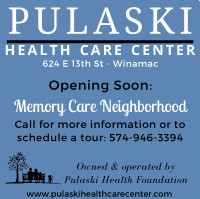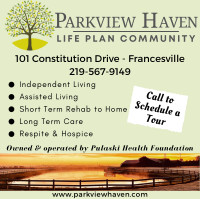 |
| Advance Directive forms are available at Pulaski Memorial Hospital at the admissions desk, by contacting the Social Service manager, and from the nurses’ station. Be sure to discuss your wishes with family members and physician, and give them copies of each document. PMH encourages you to bring in your completed documents to be scanned into your medical chart. Remember to review these documents periodically as well, since your circumstances can change. |
Pulaski Memorial Hospital offers an overview of current terminology:
- Living will: This legal document applies when someone is permanently unconscious or is suffering from a terminal illness and can’t make his or her own decisions. Depending on the person’s wishes, it allows the withholding or withdrawing of treatments that will prolong life or lengthen the dying process, such as cardiopulmonary resuscitation (CPR), artificial nutrition, mechanical respiration, certain diagnostic tests and blood transfusions. Some states refer to the living will as a health care declaration or health care directive.
- Durable power of attorney (POA): Also called medical power of attorney, this legal document designates in advance another person to make medical decisions when you are unable to do so. The designated person is known as an attorney-in-fact, agent, proxy decision maker, surrogate decision maker or patient advocate. Many advisors recommend a POA since it’s difficult to anticipate — and put in writing — every single situation that may impact your health. Still, it’s important to share your personal wishes with your designated proxy.
- Do not resuscitate (DNR) orders: Different from living wills or POA documents, DNRs are physician orders on a patient’s medical chart stating that CPR should not be used if the person stops breathing or the heart stops beating. Physicians write these because they believe the patient will not benefit from resuscitation, or because there are legal measures in place to prevent resuscitation, either through a living will or POA.
To develop a living will or designate a POA, make sure you know the legalities and terminology in your state. Like your financial affairs, your medical affairs also require careful consideration and planning.
Life choices . . . decisions concerning end-of-life care – Part 2
Making decisions about end-of-life care ensures your wishes are fulfilled. This decision may be difficult, but making your wishes known will relieve a tremendous burden on your loved ones in the future. Developing an Advanced Directive will help ensure your desires are realized.
Advanced Directives state your wishes regarding your medical care. It only becomes valid when you become incapacitated or unable to communicate. Advanced Directives can be changed at any time.
 |
| Pulaski Home Health Care and Hospice will have information and staff available to discuss end-of-life issues at the May 12 Health Fair. Advanced Directive forms are also available in the Home Health Care and Hospice office at Pulaski Memorial Hospital. |
A Living Will should not be confused with a will which refers to how you wish your property or assets distributed.
A Durable Power of Attorney for Health Care is another form of Advanced Directives. In this case you can appoint another individual to make health care decisions for you if you become incapacitated or unable to communicate. If you decide on this option you should have a serious conversation with the person you appoint to make decisions for you. It is important that they clearly understand your wishes.
Advanced Directives can also state your desires to continue medical treatment. A Health Care Choices Directive of Life-Prolonging Procedure Declaration is a document designed to communicate a person’s wishes regarding life sustaining medical treatment when the person is incapacitated or unable to communicate.
It may be difficult to put your wishes into writing or difficult for others to understand. That is why it is critical to talk with your family or loved ones about your desires.
Life choices …. decisions concerning end-of-life care and pain control – Part 3
One of the main goals of End of Life Care is to maintain the dignity of the individual. Each person and situation is unique. Often decisions must be made by the individual and loved ones concerning whether a treatment is beneficial or burdensome. The type of medical treatment should be individualized to meet the needs of the both the patient and their loved ones.
 |
| Pulaski Memorial Home Health Care and Hospice will have information and staff available to discuss end-of-life issues at the May 12 Health Fair. Advanced Directive forms are available in the Pulaski Memorial Home Health and Hospice office, online and from your attorney. |
Should pain occur, it can be relieved safely and rapidly. Many medications are available for this purpose. Medications can be given by mouth, injection, suppository, IV, an implanted device, or by placing a medication patch on the skin. Healthcare workers can adjust pain medications to provide pain relief without sedation.
Talk with your health care provider about pain and any concerns you may have. Individuals living with pain should determine the level of comfort they desire. What is a comfortable level of pain to one person is unacceptable to someone else.
Talk with your loved ones and your healthcare provider about your desires and develop a written Advanced Directive. An Advanced Directive will make known your wishes regarding the level of care you wish to receive near the end of your life. This will help to ensure your dignity and desires are maintained.







